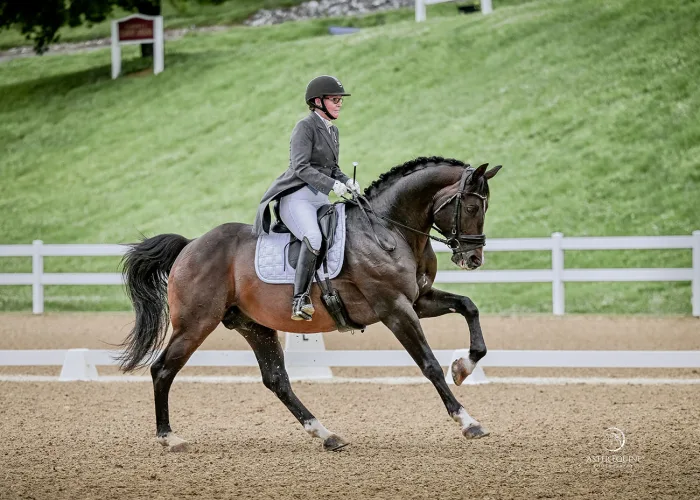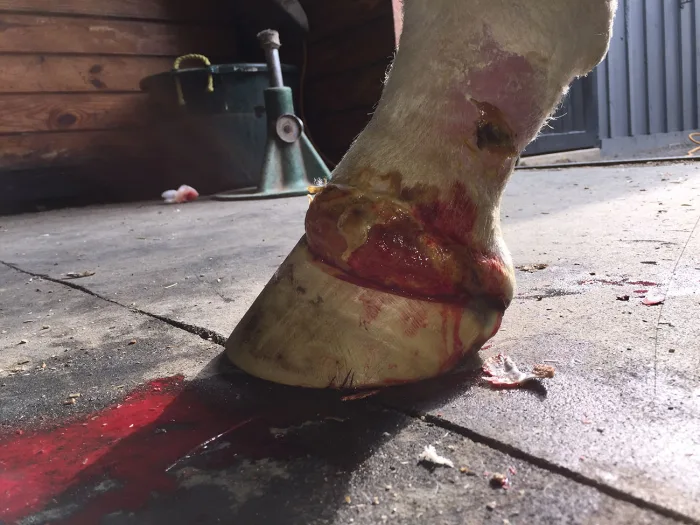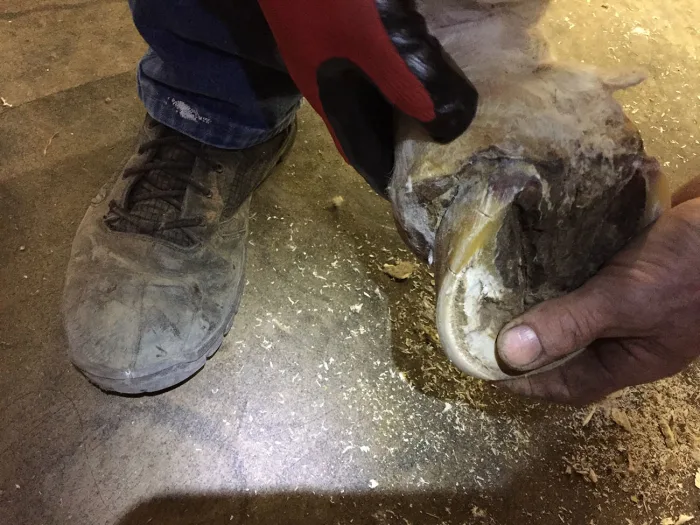Joanna Gray-Randle thought her riding days were behind her in 2009 after she had cervical spinal fusion surgery to repair damage from a car accident 10 years prior. She’d given up her busy dressage barn in California a year before the surgery when her husband, David Randle, took a new job in Long Island, New York, and she thought her body wouldn’t stand up to the physical lifestyle of a trainer and rider anymore.
But her “retirement” from horses didn’t last long. Gray-Randle soon found herself bored and started making herself available for clinics and as an ‘L’ judge for schooling shows in Region 8. After a clinic at Sandpiper Farm in Riverhead, New York, in early 2011, farm owner Gina Leslie offered her a tour of the small breeding operation. Gray-Randle was taken by a bay mare who was in foal.
“I wasn’t in the market, but I said, ‘Let me know when the foal is born,’ ” she recalled.

When Royal Tourmalet SPF (Royal Prince—Ms Adira, Armin) arrived, Gray-Randle decided she’d had enough of a retirement from horses and bought the Hanoverian.
“I met him when he was 1 day old and just never got him out of my mind,” Gray-Randle said. “I got him when he was a weanling. I liked how he was put together. I had ridden and trained stallions but hadn’t raised my own through the approval process.”
As a young horse “Artie” showed in-hand, with his biggest accomplishment coming at Dressage At Devon (Pennsylvania) in 2015, where he was the highest-scoring U.S.-bred young horse. Artie had a successful 2016 season at training level and in FEI 5-Year-Old tests, but on Oct. 20, Artie and Gray-Randle’s lives changed in an instant.
Gray-Randle had moved to Round Hill, Virginia, and was boarding Artie near Middleburg, Virginia. One morning, he was found with his right hind leg stuck between the metal bars of his stall. He’d likely been like that most of the night, and his condition was dire. He’d destroyed most of his coronary band and wounds had penetrated into the coffin joint and tendon sheath.
“Because his brain is so good, he just laid there and didn’t break his leg trying to get himself free,” Gray-Randle said.
She believes he may have become cast after laying down at night. He wasn’t wearing hind shoes, and somehow his hind foot pushed the bars apart, becoming trapped there. He was on his side, with his foot between the bars, when people found him.
“It was a pretty catastrophic situation,” she said. “Part of his hide had died from lack of blood flow. His urine was the color of coffee. He was in a critical state.” He was dehydrated, and muscle damage had resulted in myoglobinuria, or muscle breakdown products in his urine.
Gray-Randle was able to get Artie onto a trailer and take him to nearby Piedmont Equine Practice, where he underwent emergency exploratory surgery to establish the extent of his injuries. Wounds into the coffin joint and tendon sheath had resulted in infection of these structures, and the prolonged pressure on the coronary band and inside wall of his foot had resulted in a pressure necrosis of the area, meaning the coronary band and hoof wall would slough and have to regrow.
During surgery the coffin joint and tendon sheath were flushed, and the wounds sutured. In the ensuing days Artie was on antibiotics and had a series of regional limb perfusions, a procedure where a tourniquet is placed on the limb and antibiotics injected in a vein below the tourniquet to create high antibiotic levels in the region being treated, helping to address infection in the synovial structures in the injured limb. Under the care of Courtney Bolam, DVM, DVSc, DACVS-LA, and Sarah Dukti, DVM, DACVS-LA, DACVECC’s, Artie spent a month in the hospital.

Gray-Randle called the best podiatrist she could find, Vern Dryden, DVM, CJF, APF, and flew him from Lexington, Kentucky, to Virginia to help guide her and her farrier at the time, Jim Kunkel, APF.
ADVERTISEMENT
Her regular veterinarian, Katie Farrell, DVM, of South Belle Equine, was also a key part of Artie’s recovery, suggesting she contact Dryden and then coming out almost daily in the initial few weeks to help re-bandage him.
“It was definitely worrisome,” Dryden said. “I couldn’t tell them that we were going to do this, and he was going to be perfectly fine. I was concerned. It was definitely a serious injury. He’s a very lucky horse.”
First, Dryden tapped the coffin joint to check for sepsis, and when Artie’s white blood cell count was within normal range and Dryden saw that no other structures were involved besides the hoof capsule, he felt comfortable moving forward.
“That part had me worried sick. And that he would founder,” Gray-Randle said. “[Dryden] was the first one to give me hope that this was recoverable.”
Dryden put Artie in a foot cast to stabilize the hoof capsule, provide some uniform load distribution and give the growth center of the coronary band a break.
“It just wasn’t healing,” he said. “There was a lot of damage to the growth center at the coronary band. Basically, it was a stagnation of growth that resulted in almost a sinking scenario of the digit within the hoof because there was no new growth going down.”
He also did some debridement of the proximal coronary band and the hoof wall to relieve pressure there before putting on the cast.
“The coronary band was kind of prolapsing over the hoof capsule on the medial side, so we had to do a proximal wall resection and remove the impeding hoof that was compressing the growth center,” he said. “We removed that piece, and then treated the area with some sterile gauze soaked in iodine solution and compressed wraps around it, and then the foot cast.
“This case was interesting,” he added, “in that I don’t think the horse was laminitic, but with such damage to that area, it presented like a sinking case would, just because there was no growth coming from the coronary band on the medial side.”
For Gray-Randle, the give and take of the uncertain healing process required both patience and clear-headedness.
“In everything you do in this process, it has an equal and opposite reaction, and sometimes they’re good, and sometimes they’re bad, and sometimes they create things you have to overcome,” said Gray-Randle. “He had to grow out this gigantic gaping hole in his hoof, and we had to wait and see if the tissue would cornify and become hoof wall tissue again. If that wasn’t going to happen, he wasn’t going to be able to survive this accident.”
Kunkel and Farrell cut off the cast weekly to radiograph and see what the structure of Artie’s foot was doing, then Farrell sent the information to Dryden for his opinion. They would make adjustments accordingly and then recast him. That process went on for months until the cast started causing too much irritation on the pastern injury, so they put Artie in a soft cast.
Ann-Marie Hancock, DVM, EDO, of True North Equine was also instrumental in getting Artie comfortable by performing bodywork throughout his recovery.
Throughout, Artie took to the stall rest very well.
ADVERTISEMENT
“He had been fit and strong competing, and it was a complete shutdown of everything, but he’s got such a good brain that he was like, ‘OK, I guess this is my life now,’ ” Gray-Randle recalled.
The process of growing out the foot took three years. Artie never went completely lame, but his irritated pastern skin or the proud flesh, which took six months to resolve, caused discomfort. After the first two years, Artie was allowed to be in a small paddock and gradually transitioned to full turnout.
Near the end of Artie’s third year of recovery, when it looked like he was comfortable and sound, and his hoof had gone through a couple of growth cycles, Gray-Randle thought he could possibly get back into work. But he would need continued attention to his hoof.
“By cutting away the hoof wall, it altered the weight-bearing, and if you looked at his hoof from underneath, it looked like he had two hoof walls; one that was the original and one was the one that was coming out to the side because it wasn’t weight-bearing due to the hole,” she said.

Gray-Randle, now 60, had been going through her own physical issues and surgeries during Artie’s recovery, but when Artie seemed sound in turnout, she decided to get on him for “something for us to do” during the COVID-19 pandemic in 2020.
“It occurred to me at one point that he’s actually sound, and he’s strong and even,” she said. “I never thought I ever had to show him again. I’ve often said to people, ‘He gives me everything and owes me nothing.’ If he never went down centerline again, it wouldn’t matter, but as a breeding stallion, I never got the opportunity to present him to his home registry, Hanoverian, but you can get your horse approved and licensed through sport as long as you meet the qualifications. I started to think, ‘Well, maybe there’s a chance.’ ”
In 2022, the pair got back in the show ring at Prix St. Georges, and Artie got the five qualifying scores and placings he needed for his Hanoverian stallion licensing.
“I get emotional about it because this is something I had wanted to do when he was young and never got the opportunity because of the injury and felt like it was an opportunity lost,” Gray-Randle said. “He earned everything he needed in 2022. I kind of chickened out presenting him in 2022 because I’d just been through so much with him. I put it off until 2023, and I took him to his inspection in September. It was a very proud day, and a very monumental day, for the horse after everything he’d been through. I think it shows a testament to both his physical strength and mental calmness that his temperament is so amazing that he survived the accident and recovery and physically came back in the training and has been competitive at FEI. He’s just a miracle horse to me after what he’d been through.”
In May 2023, the pair competed in their first small tour CDI together at the Mid-Atlantic Dressage Festival (Virginia). She’s hoping to return this year to support the show and try to improve their scores. Her ultimate goal is to do the CDI at Dressage At Devon.
She keeps a close watch on Artie’s hoof, and while his coronet band is misshapen, said there are no other signs that he went through such a harrowing experience.
Gray-Randle keeps busy with her own riding goals on Artie as well as with teaching and judging schooling shows. She owns Artie’s first foal, Royal Madeleine CG (out of Selona ISF), who was born in 2018 and has competed in-hand. Artie has about 20 foals on the ground. Gray-Randle says that the stallion inspectors describe Artie as a “stamping sire” who passes all of his good qualities, like his level-headed temperament, to his offspring.
“I thought I’d do the surgery [in 2009] and live a stress-free life, but horses have been in my blood. It’s not what you do, it’s who you are,” she said. “I was going to stay involved, but I wasn’t looking to do active riding at the time. I figured I could teach and do clinics or judge, and that would give me enough of an outlet where I wasn’t losing half of who I was. But it didn’t stick! I’m busier now than I’ve ever been, but I love what I do.”
Do you know a horse or rider who returned to the competition ring after what should have been a life-threatening or career-ending injury or illness? Email Kimberly at kloushin@coth.com with their story.














